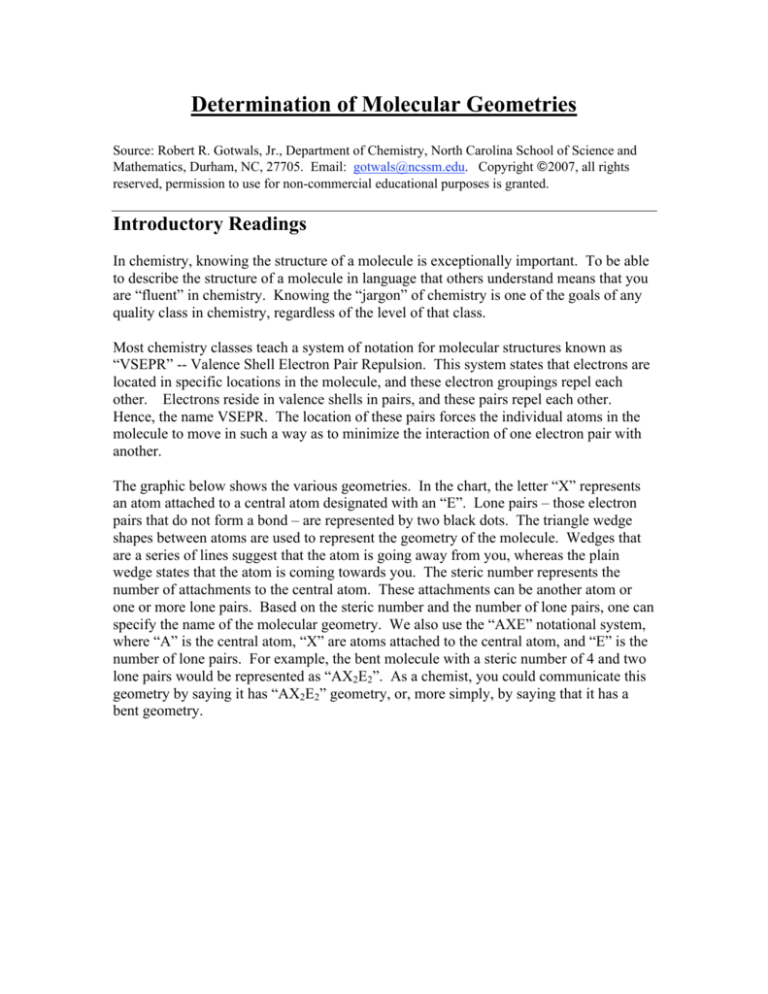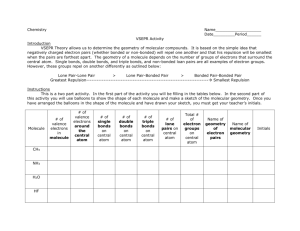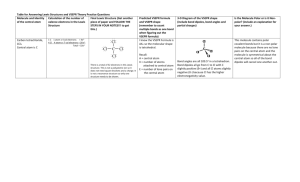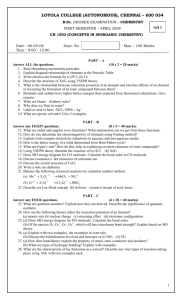
Determination of Molecular Geometries
Source: Robert R. Gotwals, Jr., Department of Chemistry, North Carolina School of Science and
Mathematics, Durham, NC, 27705. Email: gotwals@ncssm.edu. Copyright ©2007, all rights
reserved, permission to use for non-commercial educational purposes is granted.
Introductory Readings
In chemistry, knowing the structure of a molecule is exceptionally important. To be able
to describe the structure of a molecule in language that others understand means that you
are “fluent” in chemistry. Knowing the “jargon” of chemistry is one of the goals of any
quality class in chemistry, regardless of the level of that class.
Most chemistry classes teach a system of notation for molecular structures known as
“VSEPR” -- Valence Shell Electron Pair Repulsion. This system states that electrons are
located in specific locations in the molecule, and these electron groupings repel each
other. Electrons reside in valence shells in pairs, and these pairs repel each other.
Hence, the name VSEPR. The location of these pairs forces the individual atoms in the
molecule to move in such a way as to minimize the interaction of one electron pair with
another.
The graphic below shows the various geometries. In the chart, the letter “X” represents
an atom attached to a central atom designated with an “E”. Lone pairs – those electron
pairs that do not form a bond – are represented by two black dots. The triangle wedge
shapes between atoms are used to represent the geometry of the molecule. Wedges that
are a series of lines suggest that the atom is going away from you, whereas the plain
wedge states that the atom is coming towards you. The steric number represents the
number of attachments to the central atom. These attachments can be another atom or
one or more lone pairs. Based on the steric number and the number of lone pairs, one can
specify the name of the molecular geometry. We also use the “AXE” notational system,
where “A” is the central atom, “X” are atoms attached to the central atom, and “E” is the
number of lone pairs. For example, the bent molecule with a steric number of 4 and two
lone pairs would be represented as “AX2E2”. As a chemist, you could communicate this
geometry by saying it has “AX2E2” geometry, or, more simply, by saying that it has a
bent geometry.
Source: http://en.wikipedia.org/wiki/VSEPR
This notational system works very well as a communication tool to describe the geometry
of a molecule. To determine the number of lone pairs, one draws a Lewis dot structure
for the molecule. This lab assumes that the student can draw these structures. Drawing
Lewis dot structures is, however, a relatively tedious endeavor, and we would like to be
able to determine the molecular geometry of a molecule without determining its Lewis
structure.
Computational chemistry can help with this challenge. All of the modern computational
chemistry software packages – Gaussian '03, MOPAC, GAMESS, etc. -- routinely
generate what is known as a “point group symmetry” determination for every molecule
that is evaluated. Point group symmetries are closely analogous to the VSEPR
geometries, but use a different, and more complicated, notational system. The various
notational terms include items such as C2v, D3h, and Td. These various terms are
determined by a careful analysis of the various ways that the atoms in a molecule can be
rotated, reflected through a plane of symmetry, and otherwise manipulated. Being able to
determine a point group symmetry by hand is exceedingly more complicated than
determining the AXE notation for a given molecule. Point group symmetries are,
however, more commonly found in the chemical literature than are VSEPR notations.
There are a number of excellent tutorials, such as
http://www.reciprocalnet.org/edumodules/symmetry/index.html
Assuming, however, that we don’t want to learn how to determine point group
symmetries by hand, and we don’t want to draw Lewis structures for every molecule we
study, how can computational chemistry help us? As before, all computational chemistry
software packages determine the point group symmetry of a molecule. For most scientists
working in chemical research, knowing the point group symmetry of a molecule is more
than adequate for communicating with other scientists. For example, the graphic below
shows the molecule PCl5, phosphorus pentachloride. The VSEPR notation for this
molecule is AX5, meaning it has five atoms (Cl) attached to the central atom (P), with no
lone pairs, as determined by a Lewis dot structure analysis. Based on this determination,
the VSEPR geometry of this molecule is trigonal bipyramidal. As you can see under the
label “symmetry”, this molecule has a D3h symmetry. This means that the molecule
belongs to a geometric family of “dihedral” molecules with three rotational modes
through a horizontal plane (i.e., 3h). The various tutorials illustrate these rotations well,
and the curious reader is strongly encouraged to go through these tutorials.
.
The graphic below shows the correlation chart between point group symmetry notations
and VSEPR notations. For example, since the PCl5 molecule has been determined to
have D3h symmetry, the chart tells us that it has trigonal bipyramidal geometry using
VSEPR and Lewis dot structure notation. Using AXE notation, we identify this molecule
has being AX5, with five atoms attached to the central atom with no lone pairs. From the
VSEPR chart, this also corresponds to trigonal bipyramidal.
Based on this reading, you should now be able to implement the computational approach
procedure described below and determine both the point group symmetry and the VSEPR
geometry of any molecule.
TECHNICAL NOTE: the computational chemistry software packages represent the
infinity (“∞”) symbol in the point group symmetry chart with an asterisk (“*”).
TECHNICAL NOTE: linear molecules in VSEPR theory can also be correlated to D∞h
(D*h) point group symmetry
Computational Approach
The following procedure is identical for all molecules. For demonstration purposes, this
lab uses the molecule phosphorus pentachloride (PCl5).
Building the Molecule
1. Log into the chemistry server.
(http://chemistry.ncssm.edu)
2. In the Job Manager, click on “New
Job”.
3. Once the molecular editor opens,
click on “Open Editor” at the bottom
of the window. The Java label
4.
5.
6.
7.
8.
9.
should appear. On most machines, it will take Java a few minutes to open.
A drawing window should open. Click on “Other”, and a periodic table window
should appear. Alternatively, you can click on the periodic table icon on the left
menu bar. Choose “P” for phosphorus.
Click once in the drawing window. A purple phosphorus atom should appear. If
more than one atom appears, select “File New”, then select “Tools Build”,
then try again.
Open the periodic table again, and choose Cl (chlorine). Place 5 chlorine atoms
around the phosphorus atom. Connect each chlorine to the phosphorus by drawing
a line between each pair of atoms (click-hold-drag).
Under “Cleanup”, perform a comprehensive cleanup. This should make your
molecule look more symmetrical.
Close the builder window by choosing “File-->Close”. Alternatively, you can
simply click back into the main window. Make sure your molecule shows up
before proceeding!
To move to the next step, click on the “next” arrow at the bottom right of the
window.
Configuring the Job
To prepare your molecule for calculation,
follow these steps:
1. Choose the computational
engine: any will do except
Tinker. MOPAC typically runs
the fastest. Once you have chosen
an engine, click on the bottom
right arrow to go to the next
window.
2. In the Job Option window you will need to choose the following options
a. Job Name whatever you
want to call your calculation
b. CalculationDrop down
menu, choose Geometry
Optimization
c. Theory Choose HartreeFock for GAMESS or
Gaussian, PM3 for MOPAC
d. Basis Set Basic: 3-21G
for GAMESS or Gaussian
e. Charge 0
f. Multiplicity Singlet
3. Click the “next” arrow in bottom left hand corner; this should take you back to the
job manger window. You should see your job running in the window or queued
up.
4. You can click on the word “Refresh” to see the progress of your calculation. This
is particularly helpful if you are in the “queue”.
5. Once your job is completed, click on the name of the job, scroll down to find the
point group symmetry for your molecule (labeled as “Symmetry”).
Data Analysis
Once your “job” is completed, follow this procedure:
1. To view the results of your completed job you may click on the name or the
magnifying glass at the end of the job.
The chart below includes a number of interesting molecules for you to try. You should
be able to complete this chart. Alternatively, you can perform molecular geometry
determinations of molecules assigned to you by your instructor.
TECHNICAL NOTE: the computational chemistry software packages represent
the infinity (“∞”) symbol in the point group symmetry chart with an asterisk (“*”).
Sample Data Table for Molecular Geometries Determination Lab
Molecule
PCl5
BeF2
BF3
GeCl2
CH4
H2O
NH3
SF4
ClF5
Lewis Dot Structure
Predicted
VSEPR
geometry
Calculated
Point Group
Symmetry
VSEPR
shape from
chart
Trigonal
bipyramidal
(AX5)
D3h
Trigonal
bipyramidal









